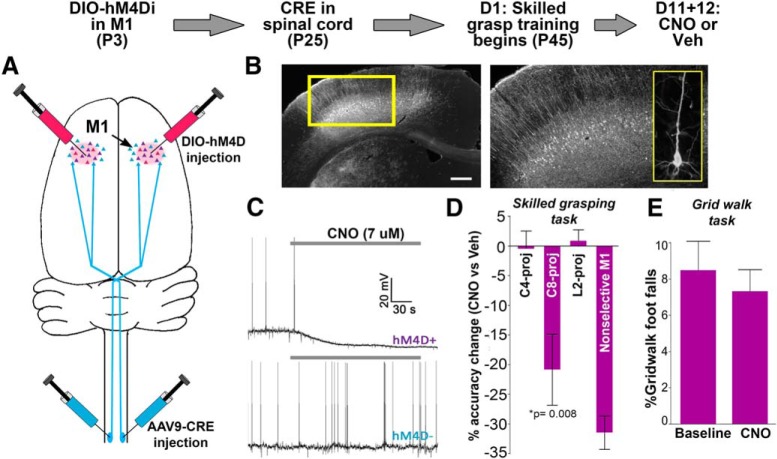Figure 4.
Selective inhibition of C8-projecting corticospinal neurons impairs performance of the learned skilled grasping behavior. Top, Timeline for targeted cell inhibition. A, At 3 d postnatal, injections of cre-dependent virus expressing hM4D(Gi) were targeted to M1. At age 25 d, the same animals received spinal cord injections of cre-expressing virus at one of three spinal cord locations: C8, C4, or L2. B, Cortical expression of hM4D(Gi) was specific to layer 5 motor cortex. Inset, Individual layer 5 pyramidal cell expressing hM4D(Gi). Scale bar, 400 μm. C, Whole-cell slice recordings demonstrated CNO-induced hyperpolarization > 5 mV in hM4D(Gi)-expressing neurons (n = 5/5). Neighboring layer 5 neurons not expressing hM4D(Gi) did not show hyperpolarization in the presence of CNO (n = 0/5). Gray bars represent CNO application. D, Animals underwent 10 d of training on the skilled grasping task, which required animals to retrieve a 45 mg sugar pellet with a single forepaw. Pellet retrieval was impaired in the presence of CNO (5 mg/kg) versus vehicle in animals expressing hM4D(Gi) in C8-projecting cells. In contrast, performance was unaffected by CNO in animals with hM4D(Gi) expression in corticospinal neurons largely unrelated to grasping (C4-projecting), or negative control animals with hM4D(Gi) expression in neurons controlling the hind limbs (L2-projecting). Animals receiving injections of non–cre-dependent hM4D(Gi) virus directly into M1 were predictably impaired in the presence of CNO (n: C8 = 9, C4 = 7, L2 = 5, M1 = 2). Error bars = SEM. E, Unlike the fine motor refinements required for acquisition of the skilled grasping task, the grid walk is an unskilled motor task that does not require training of motor outputs controlled by the motor cortex. Accordingly, inhibition of the C8-projecting corticospinal subpopulation (n = 6; CNO = 5 mg/kg) did not impair grid walk performance (p = 0.578). Error bars = SEM.

